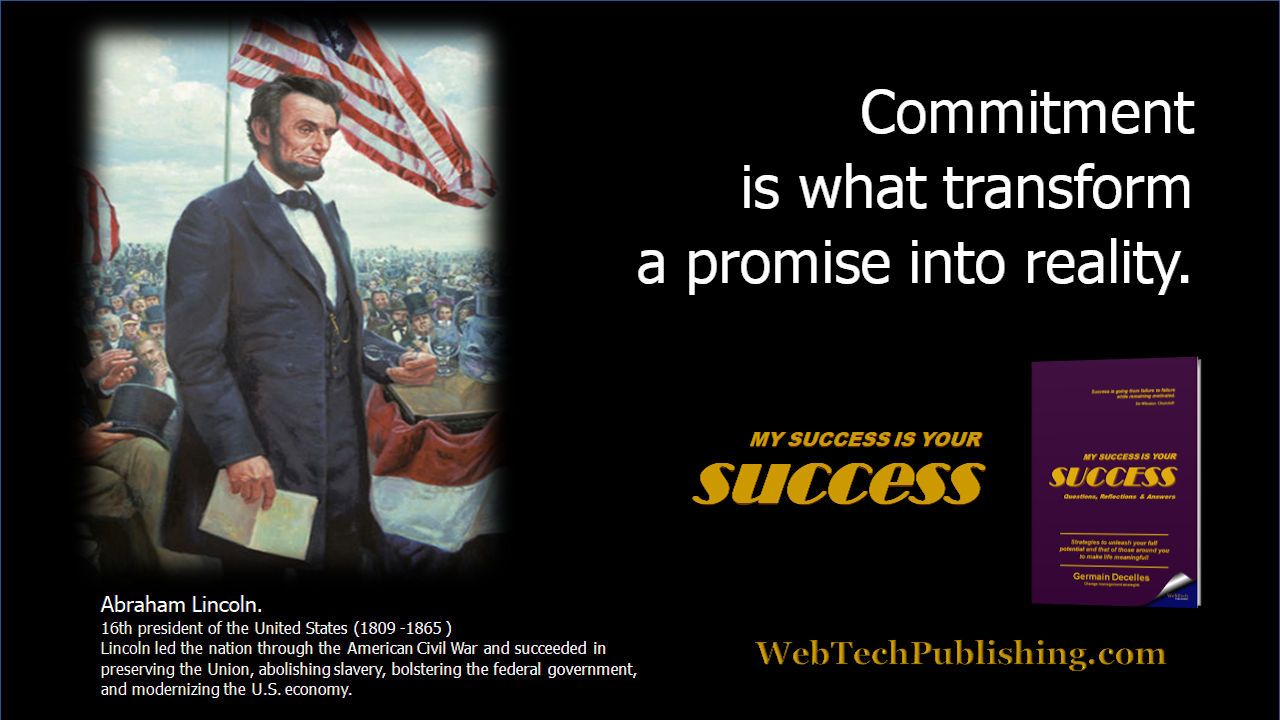|
Article published on LinkedIn.com:
April 27, 2024
36_commit_work_En.pdf

The quotations, short texts, and photographs in this
work remain the exclusive property of their respective
authors.
COMMITMENT TO WORK
Work engagement is defined as the level of enthusiasm of an
employee, volunteer or boss towards the tasks assigned to them
in a workplace.
It is the sense of responsibility that a person, has towards
the goals, vision, and mission of the organization with which
he is associated.
High levels of employee satisfaction in an organization are
linked to a commitment to work and to one's organization. This
results in superior performance, which in turn results in
increased profitability, productivity, employee retention
and overall improved working
atmosphere.
However, most great things in this world are achieved
through persistence, hard work, and dedication. All of these
qualities are not just manifested in one day.
A person develops these qualities over the years. The
same goes for organizations, if an organization expects its
employees to perform exceptionally well, it will need to
provide a work environment that will help increase engagement
at work.
How to improve your engagement at work?
Improving work engagement cannot be done in a single
day.
It takes time to bring higher levels of engagement to the workplace.
Below you will find tips
for making effective and immediate changes to achieve the
desired success. It is important that both the employee and
the boss participate actively and above all in a positive way.
1.
Build a strong team:
teamwork works wonders. Organizations should develop a culture where
teamwork should be important.
Achieving goals together makes difficult tasks easier to
accomplish.
Teamwork depends on the ability of employees to interact and
work in tandem with the boss, so they can function as a group.
2.
Let the team know what you expect of them:
hard-working
employees are an asset to an organization. Most employees want
to be part of the success story of the organization with which
they are associated.
Therefore, it is important to clearly communicate the goals,
vision and mission to employees. This way, employees will know
what the organization expects of them.
Clarity of thoughts is important during the tenure. With
clarity comes the determination to work and achieve
excellence.
3.
Foster a culture of transparency:
the
organization must be transparent. Let employees participate
freely in discussions, important decisions related to
employees and the contribution they can make to the
organization.
When an organization informs its employees, they feel valued
and trusted. This increases their sense of belonging and,
therefore, their commitment to work.
4.
Foster, open, free communication:
open and free
communication within an organization facilitates an
environment of trust. The open door policy is one way to
promote free communication. Additionally, an organization can
use employee satisfaction surveys, polls, etc. to provide
feedback to the organization.
When receiving this feedback, organizations should keep an
open mind to interpret and then respond logically to employee
expectations with the goal of improving the work culture,
without criticizing the employees who provided the feedback.
Take advantage of these comments. Once employees know their
suggestions or feedback is appreciated work engagement will
increase.
5.
Establish a strong work ethic:
work ethic includes not only
how an employee feels about their job or career, but also how
seriously they take their job responsibilities.
It involves a positive
attitude and behavior, respect for colleagues, effective
communication, and interaction in the workplace. The work
ethic shows who and how a person is.
Historically, successful
organizations have worked tirelessly to introduce, improve,
and promote work ethics, honesty, integrity, and
accountability.
These key factors contribute
to establishing and improving a work ethic with the aim of
increasing the chances of success.
When employees demonstrate
such values in an organization, they are tempted to stay and
commit to the organization.
6. Develop a culture of
trust: trust is an essential factor that brings
exceptional results in any relationship.
Trust is not just a plaque on
the door, a welcome sign telling employees:
« Here, we offer trust. » Both the boss and the
employee must do everything possible to create an environment
of mutual trust.
It involves a lot of effort
from senior management and the organization as a whole to
introduce and promote this culture in the organization. Trust
is earned by putting a consistent effort into everyday
actions.
When an organization promotes
such a culture, it attracts employees who will have a real
impact on the organization in all the right ways and thus
increase work engagement.
7.
Make use of innovation: let your employees be innovative by coming up with ideas, strategies,
means of communication, etc.
Innovators are engaged
collaborators. These employees are always looking for better
ways to perform even the most mundane tasks.
These employees should be
valued by organizations and encourage them to come up with
better ideas and reward their achievements and innovations.
8.
Help your employees to
develop:
an organization that helps its
employees grow professionally and personally and respond to
their logical aspirations in a positive way is much more
likely to be in a position to have people working for the
organization for long periods of time.
An organization can support its employees by providing
learning opportunities, cross-training, and any other
interactive method that supports their overall development.
Such gestures help organizations to retain their employees
while engaging them more in their work.
9.
Offer incentives:
organizations need to reward employees who perform exceptionally well.
Each person has different things that motivate them.
Incentives linked to follow up and results make employees feel
important.
It is important for organizations to recognize the hard work of
employees to achieve the desired result.
Incentives should be
awarded based on objective criteria.
10.
Celebrate success:
employees need to feel validated and valued by the
organization.
The leader must show that
he cares for them.
Employees do not leave an organization if they know their
opinions matter, if they are treated fairly, if their
achievements are recognized and if they feel part of an
organization.
Celebrate success with your employees, tell them they made a
difference, encourage them to do better. The slightest gesture
will lead them to improve with each passing day.
This will lead to better engagement at work.
11.
The difference between involvement and commitment:
involvement and commitment are
different, although there is some overlap.
The employees involved are engaged and it shows through their
actions and work ethic. They will be more attentive,
productive, responsible, and energetic in their work.
Although the two terms are often used interchangeably, there
are obvious differences. For example, we may claim to be
committed, but we do not demonstrate through our work that we
are.
12.
The benefits of commitment to
work:
a team of dedicated employees
is an organization's dream come true.
A team, of engaged employees is the best solution for the long-term
future of an organization or any business.
The leaders within the organization as well as the positivism of the
employees are responsible for building this culture.
Here are the advantages of having a team that is committed to work:
·
Increased
productivity:
engaged employees need a leader to guide them. They don't need
someone who has to be constantly behind them to get things
done.
Such organizational commitment results in
increased workplace productivity.
A compliant team will create their own tasks and ensure they
are implemented. They will show up on time to get the job done
and even go the extra mile.
·
The goal is
reached:
a complacent
team will only do what is asked of them, a committed team will
do that and more to achieve their targets and objectives.
An engaged team understands the goals and their individual
role in achieving those goals. They are driven and set higher
goals than what is expected of them.
For a committed team, goals aren't just a number, a date, or a
target. It is for them a vision, an adventure!
·
Spread the
« joie de vivre» at
work: in simple terms, an engaged team promotes enthusiasm
and joie de vivre in the workplace.
Engagement brings ownership
and more creativity in tasks. A committed team thrives on new
and innovative ideas, and it's fun to implement such ideas
again and again.
Engagement at work brings added value through active
participation in company-related discussions.
Engaged employees contribute great ideas and are always happy
to help others visualize those ideas.
An organization needs
commitment and dedication from its employees to achieve its
goals.
To download this and previous articles, go to WebTech
Publishing (www.webtechpublishing.com)
and click on the green image (e-NewsLine).
To learn more about how to inspire success, visit WebTech
Management and Publishing Incorporated (www.webtechmanagement.com)
and click on the blue image (Wise whiZ) at the bottom right of
the screen.
|

|
This book is the result of forty years
of experience acquired with local and international
organizations and companies and during consultancy,
change management, transition and marketing services.
This 404-page
personal development book was published by WebTech
Publishing and is available online in English, North
American French and European versions. For more
information and to view the flip book, visit
webtechPublishing.
|
About the Author
Decelles
Other publications:
ISO Pour Tous
– Le manuel
d’information ISO – Le guide de préparation ISO – La
gestion du changement en affaires – La gestion de
projet d’affaires – Le
changement POUR TOUS –
Change your future,
now! – Mon succès est votre succès.
Press Contact
Germain Decelles, o.s.j.
WebTech Management et Publication Incorpored
|
 |
—30 —
|